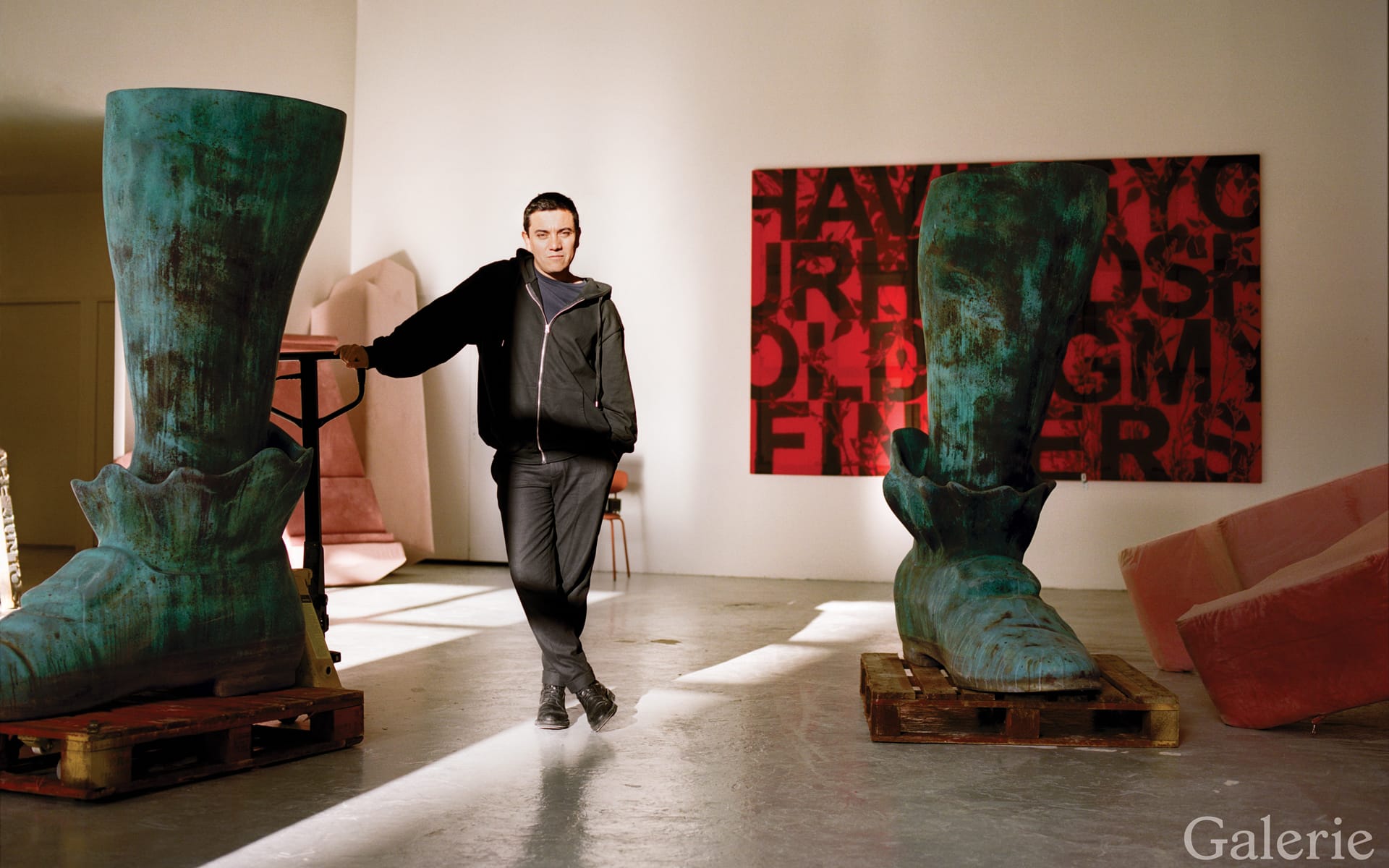Iván Argote Opens His Paris Studio Ahead of a Major Spring Exhibition at Perrotin New York
With his often playful, visually striking takes on the world around us, the artist explores issues including power, justice, and humanity

For Iván Argote, an artist whose work routinely skewers the spurious grandiosity of public monuments, proposing a sculpture for the Plinth on New York City’s High Line presented a distinct challenge—and an opportunity. His winning design, a new kind of monument for the 21st century that is also a multilayered symbol for the city, is a giant pigeon standing 16 feet tall atop a pedestal on an old rail spur that overlooks 30th Street and 10th Avenue. Titled Dinosaur—indeed the replica of the ubiquitous bird is the size of some of its extinct colossal ancestors—Argote’s hyperrealistic, hand-painted aluminum statue is at once majestic and banal, strange and funny, imposing and sympathetic.

“It’s a monument to the disliked ones or the ones that were put aside or marginalized,” says the artist and filmmaker, born and raised in Bogotá, Colombia, and based in Paris since immigrating to France at age 23 to get his MFA. On view through May 2026, Dinosaur became an instant social media favorite when it debuted in the fall.
“This was an opportunity for Iván to use the language of monumentality but turn it upside down by commemorating something normally not seen on a large pedestal,” says Cecilia Alemani, director and chief curator of High Line Art, who notes that the work has attracted a subculture of pigeon lovers as well as actual pigeons, which flock to its base. “It’s also an invitation to think about our perception of what is welcomed and not welcomed anymore in our cities,” she adds, drawing a connection to the broader conversation about immigration that is part of Argote’s research as an artist.


Since 2023, he has worked from a light-filled studio in the new arts neighborhood of Komunuma. “I designed all the spaces specifically for us and the kind of works we do.”
Over the past 15 years, Argote has become known for his puckish guerrilla-style interventions in public spaces that often recast statues on pedestals—those glorifying representations of historically powerful men he refers to irreverently as the “mustache guys.” For the Venice Biennale last year, the artist created a replica of a statue of Christopher Columbus—after whom his native country is named—that lay on the ground in pieces, seeded with a garden of migrant plants that had almost consumed the sculpture by the show’s end. In his photographic series “Turistas,” Argote surreptitiously dressed statues of Spanish conquistadores in Madrid, Bogotá, and Los Angeles with indigenous ponchos, reducing the colonizers to tourists in local garb. For his film Levitate, he convincingly simulated the removal of well-known memorials in Rome, Madrid, and Paris using huge cranes.


The “Turistas” photographs and Levitate are both part of Argote’s upcoming solo exhibition at the Perrotin gallery in New York, opening on April 23. The centerpiece of the show is a large-scale installation comprising archetypal statues depicted in decay titled Señores.
Argote is also currently working on a pair of weathered bronze boots evoking a fragment of an anonymous monument but scaled up to a surreal seven feet tall and planted with trees. Addressing the cultural question of what to do with problematic statues that have been removed from public squares around the world in recent years, he reimagines them as “containers of soil and plants where they have a better use maybe,” he says, “making them a bit more alive.”


The son of teachers and political activists, Argote grew up in a working-class neighborhood on the outskirts of Bogotá until age 14, when his family moved downtown and he discovered these historical markers for the first time. “It was always curious to me,” says Argote, who spent a lot of time skateboarding in public squares as a teenager. “What is the meaning of having this sculpture here?”
Argote studied graphic design and cinema at the national university in Bogotá before winning a travel prize for an installation of experimental videos and photographs he contributed to a local exhibition. He chose Paris, where he learned the language, entered art school, and began making a series of short video performances.
In one early piece, he persuaded strangers in a crowded subway elevator to sing “Happy Birthday” to him. “Being a migrant, I was trying to get adapted to a new city,” he says, “and then using that as a tool to question things about how we interact in society.”


As part of his continuing interest in generating situations where people can connect, confronting their distance and mistrust of others, Argote is doing a yearlong presentation of his interactive sculpture The Other, Me & the Others outside the São Paulo Museum of Art in Brazil, starting in late March. The work (an earlier version was shown at the Lyon Biennale last year) is essentially a gigantic seesaw, a 50-foot-long horizontal platform balanced on a system of springs, that people can mount at the center.
“As soon as someone enters, the equilibrium is affected,” says Argote, describing how people will look at each other and try to figure out how to keep the platform level. “It creates this interaction. Sometimes they talk. Sometimes they laugh. Sometimes they create two massive groups. It doesn’t work if you don’t play the game with others.”
A version of this article first appeared in print in our 2025 Spring Issue under the headline “Revisions of Grandeur.” Subscribe to the magazine.
